Abstract
This study investigates the financial interconnections among Real Estate Investment Trusts (REITs), sukuk (Islamic bonds), and oil in Gulf Cooperation Council (GCC) nations. The study sample comprises S&P GCC Composite Equity Real Estate Investment Trusts (REITs) Shariah, the S&P GCC Bond and Sukuk Index, and the OPEC crude oil basket on a daily basis. The duration of coverage spans from 2014 until the beginning of 2024. The TVP-VAR methodology is utilized to examine the interrelationship among the assets. The results indicate that Real Estate Investment Trusts (REITs) and oil are sources of volatility transmission, whereas sukuk is a recipient of volatility within the network. Examining the net pairwise directional linkages of two assets, namely REITs and oil markets, reveals that they transfer their volatility to the sukuk market. Moreover, a reciprocal relationship exists between REITs and oil regarding volatility spillover. It means that REITs act as transmitters to the oil markets during specific periods, while the influence is reversed at other times. This study implies that portfolio managers and investors can discern the volatility patterns of assets in order to enhance their risk-management techniques. For policymakers, comprehending the interdependence of certain asset classes provides valuable knowledge for formulating regulations that might stabilize the financial system and foster economic growth. From a research and academic perspective, this study enhances understanding of the interconnections between different financial asset classes and pricing dynamics in financial markets.
1. Introduction
Understanding the economic stability and investment dynamics of the Gulf Cooperation Council (GCC) countries requires a close examination of the financial market connectedness with oil price fluctuation. A large number of studies on this correlation have been conducted rigorously, including, for example, Shahzad et al. (2019); Demirer et al. (2020); Sharif et al. (2020); Aloui and Hamida (2021); Tien and Hung (2022); Antonakakis et al. (2023); Umar et al. (2023, 2024); Fasanya and Oyewole (2023); Hanif et al. (2023); Mensi et al. (2023); Mezghani and Abbes (2023); Zhao et al. (2024); Rehman et al. (2024); and Danila (2023a, 2023b).
Nevertheless, research on the interdependencies between sukuk, oil, and Real Estate Investment Trusts (REITs) has not yet been conducted. Oil constitutes the main source of government funding for GCC nations. Recently, REITs have gained significance, with sukuk utilized as a financing tool for real estate or public projects. Do these assets spread volatility among themselves? In order to address this gap, this study aims to examine the relationship between these financial market instruments and the volatility of oil prices in GCC countries. Given the fact that GCC’s economic structure, which heavily relies on oil revenue and Islamic finance instruments such as sukuk, are widely used, analyzing how volatility in oil prices influences sukuk and REITs provides valuable insights for policymakers in devising better financial stability tools and mitigates the economies turmoil against oil price shocks. For instance, if the spillover volatility between sukuk, oil price, and REITs exists, then monetary adjustments are conducted to stabilize the market during the turmoil period. Investors can adjust their portfolios accordingly. The development of more resilient financial instruments relevant to REITs, which are growing asset classes in GCC countries, can be channeled. Finally, when the market participants acknowledge the connectedness of the assets, they can make decisions rationally, which enhances market efficiency.
This study employs the time-varying parameter vector autoregression (TVP-VAR) model to comprehend the dynamic volatility spillover across various markets and assets with a robust framework. These models’ ability to accurately represent time-varying connections makes them particularly effective for financial and economic research, where structural changes and regime transitions occur frequently.
This study enhances the current theory by providing evidence that REITs and oil play a role as volatility transmitters, whereas sukuk serves as a recipient of volatility within the network. An analysis of the net pairwise directional linkages of two assets, REITs and oil markets, demonstrates that they transmit their volatility to the sukuk market. Furthermore, there is a reciprocal connection between REITs and oil regarding the transfer of volatility. This implies that REITs serve as receivers to the oil markets during some time periods, while their impact is reversed at other times. The significant correlation among REITs, sukuk, and oil highlights the necessity for economic diversification within GCC countries. The economy and its financial markets exhibit significant vulnerability due to a heavy reliance on oil revenues, which are subject to fluctuations in oil prices. Diversifying into other sectors, such as tourism, technology, and manufacturing, can effectively reduce dependence and mitigate the volatility in oil markets from impacting the broader economy.
The remainder of this paper is structured as follows: Section 2 describes the literature review. Section 3 presents the study’s data and methodology. Section 4 elaborates on the discussion and recommendations based on the data analysis. Section 5 contains the conclusion, which emphasizes the relevance of our findings.
2. Literature Review
Oil is a central economic driver in GCC countries. Oil is a primary source of revenue for public spending, government budgets, and overall economic growth. Changes in oil prices have an impact on government revenues, which influence public infrastructure projects, private sector investments, and real estate demand. This, in turn, influences REITs and sukuk, particularly when sukuk finances real estate or public projects. As a result, volatility in oil prices spreads through these sectors, amplifying economic cycles.
The study of volatility spillover among asset classes reveals how shocks in one market link to another, highlighting market integration and financial system vulnerability. This interconnectedness indicates a high level of market integration in the GCC, where the financial and real estate sectors are sensitive to changes in oil prices. The spillover effects can exacerbate financial instability, making the entire system more vulnerable to external shocks.
Nazlioglu et al. (2020) investigated price and volatility transmission between oil and REITs in 19 developed and emerging markets. The impact of oil prices on the REIT markets is significantly prevalent in advanced countries. However, the reverse effect is rather negligible. Huang and Lee (2009) reached the same conclusion about the impact of the oil price shock on REIT markets. Regarding the volatility spillover, the study shows a bidirectional transmission between the assets in the markets’ majority.
Nevertheless, using six categories of REITs, namely residential, hotel, healthcare, retail, mortgage, and warehouse/industrial, Nazlioglu et al. (2016) reported unidirectional price transmission from the oil market to REITs, except for mortgage REITs. Contrarily, Mensi et al. (2023) argue that the transmission shock is from REITs to oil markets. In addition, the authors suggested that equity investors should prioritize including REIT assets in their portfolios above oil futures to mitigate risk without compromising expected profits. In the same vein, Fasanya and Oyewole (2023) reported that the connection between REITs and oil markets is strong, with REITs acting as a net volatility transmitter and the oil market acting as a net volatility receiver.
Furthermore, Antonakakis et al. (2016) found an adverse relationship between the oil and housing markets in the US, meaning that they tend to move in opposite directions. According to Killins et al. (2017), a few reasons for the negative correlation between the two asset markets are as follows: the increase in energy prices affects households’ income and expenditures, directly or indirectly, leading to a decrease in housing demand. Kilian (2008) suggested that oil price shocks primarily affect the demand for houses and cars. The increase in oil prices also drives up construction and building costs, leading to a supply-side adjustment. The monetary policy’s response to the inflation pressure resulting from rising oil prices diminishes the liquidity in housing markets, causing a decline in housing demand. Finally, the energy asset return’s attractiveness shifts the investment flow from real estate assets to energy assets.
Looking into the co-movement among REITs worldwide, Alhassan et al. (2021) argued that the co-movements increase over time after controlling the common risk factor. The effect is more pronounced for larger and more liquid REITs. Therefore, the extent of transmission depends on various country-level factors, including the exchange rate, market condition, financial development, governance, and credit constraints.
Furthermore, the connectedness between bonds (sukuk) and oil prices is contingent upon the country’s status as an oil importer or exporter. Theoretically, an increase in oil prices will trigger inflation, leading to a rise in the nominal bond yield. Consequently, the price or return for oil-importing countries will move in the opposite direction. In the meantime, the high oil price increases domestic income, resulting in a higher demand for investment in financial assets. As a result, both the price and return gain momentum. Balcilar et al. (2020) confirmed that the uncertainty of the oil price increases both the return and volatility of bond premia of the US Treasury, which has a more substantial impact on its volatility.
Regarding volatility spillover, Nazlioglu et al. (2020) reported that the transmission of volatility from the bond market to the oil market is more noticeable, except for two countries, namely Kuwait and Saudi Arabia, where the bond market is in an underdeveloped stage. Meanwhile, the opposite transmission of volatility exists in the case of some major oil exporters—Kuwait, Norway, and Russia—and one importer (France). Nevertheless, a study by Rehman et al. (2024) found a limited correlation between green bonds and oil markets. Specifically, Norway and Sweden exhibited considerable co-movement at low frequencies. The authors also noted that the correlation between the returns of the two markets fluctuated over the time of the crisis.
Lin (2013) examined the spillover effect of government bonds on REIT volatility. The author found that a higher bond return leads to the volatility of the REITs market in ASIAN markets, which aligns with the capital asset pricing model (CAPM). The theory posits that a risk-free rate fundamentally prices an asset’s return, using government bonds as a proxy for this rate. Therefore, the volatility of government bonds drives an asset’s volatility, in this case, REITs.
3. Data and Methods
This study uses daily data on oil prices, sukuk, and REITs. The sample period is ten years, from May 2014 to May 2024. Using 10 years of daily data for a TVP-VAR analysis provides a balance between capturing short-term dynamics and long-term trends, detecting structural changes, and producing reliable forecasts. Environments where relationships between variables change over time, and where high-frequency data can offer significant insights, in particular, justify this approach. Table 1 shows complete data information, including its source.

Table 1.
Description of data.
Return is calculated as Rt = 100 × ln (Pt1/Pt−1). We use the model suggested by Diebold and Yilmaz (2012) and Antonakakis et al. (2020), the time-varying parameter vector autoregression (TVP-VAR) model. This model effectively reflects the dynamic interactions and interdependencies across numerous time series variables, enabling the flexibility for parameters to vary over time. Furthermore, the model’s advantages include capturing structural changes in the data over time and being flexible in modeling non-stationary processes. Structural change implies that the model can detect and adapt to significant shifts in the economic environment or the relationships between variables. Policy shifts, technological innovations, financial crises, or other significant events could cause these changes by altering the dynamics between the variables. We notice that oil prices, REITs, and sukuk are subject to changes due to policy shifts, technology changes, and other significant events.
The model for the overall connectedness index is as follows:
The connectedness technique shows how a disturbance in one variable spreads to affect other variables. The transmission of effects from variable i to all other variables, j, referred to as total directional connectedness to (“TO”) others, is defined as follows:
The directional connectedness variable i receives from variables j, called total directional connectedness from (“FROM”) others, is defined as follows:
Net total directional connectedness, which can be interpreted as the influencing variable i has on the network, i.e., identifying a variable as a transmitter or the receiver of spillover (“NET”), is defined as
The net total directional connectedness concept involves analyzing bidirectional interactions by calculating net pairwise directional connectedness (NPDC).
The hedge ratio, as proposed by Kroner and Sultan (1993), is calculated to determine the extent to which investors are willing to reduce the risk of a portfolio. It suggests that if a short position in another asset hedges a long position in one asset, the optimal hedge ratio between the two assets can be determined as follows:
where is a hedge ratio with a one-dollar long position in one asset and a one-dollar short position in a second asset. When the value is negative, the interpretation is the opposite, i.e., a one-dollar short position in one asset and a one-dollar long position in a second asset.
4. Results
4.1. Descriptive Statistics
Table 2 presents summary data for REITs, sukuk, and oil. The mean values for all samples approximate zero, indicating that the average of the samples is concentrated around zero. Moreover, the variable with the greatest mean value is sukuk, i.e., sukuk places the highest return among the assets. As for standard deviation, oil return is the highest, suggesting the most volatile asset.

Table 2.
Summary statistics of REITs, sukuk, and oil.
Except for REITs, all variables demonstrate skewness, meaning they deviate from the normal distribution curve outside the range of −0.5 to 0.5. Furthermore, the skewness is negative for all variables, indicating that their values are above average. All data demonstrate leptokurtic distributions, indicating the presence of substantial outliers. The Ljung–Box Q statistic indicates a significant level of autocorrelation in all series. LM displays ARCH/GARCH errors. The Q-stats and LM-stats suggest a suitable TVP-VAR model with time-varying variances.
4.2. Dynamic Connectedness Analysis
Table 3 presents the dynamic spillover effects between each asset and system. The label “From Others” in the final row denotes the directional connectivity that each asset receives from the system. Furthermore, the “To Others” label at the bottom of every column signifies that each asset disseminates its impact on the other assets. This table indicates that oil is the most prominent transmitter among the assets, with REITs closely behind. In contrast, sukuk has the lowest transmission power compared to the other assets.

Table 3.
Dynamic connectedness between REITs, sukuk, and oil.
Regarding the spillover receiver, oil receives the most spillover from the network, followed by sukuk and REITs. Nevertheless, based on the “Net” designation, it is evident that REITs and oil are the net transmitters to the network, and sukuk receives net spillovers from the network. In addition, REITs are a higher transmitter than oil. The finding is supported by (Huang and Lee 2009; Nazlioglu et al. 2020). Figure 1 exhibits the network of three assets.
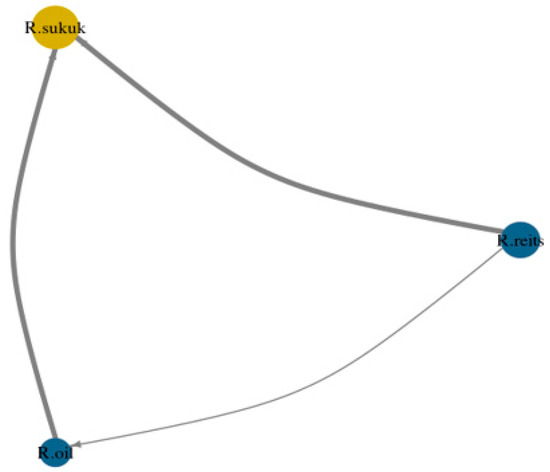
Figure 1.
Assets network.
Figure 2, Figure 3, Figure 4 and Figure 5 graphically show the dynamic connectedness to highlight all assets’ connectedness. Figure 2—Total Connectedness Index (TCI) displays the average impact of a shock in one series on all others. TCI shows the peak impact of an asset series on the others at the beginning of 2016 and early 2020, with an average value approaching 40%. Several crises occurred during that time, including the Venezuelan economic crisis and the outbreak of COVID-19. The correlation between the three asset classes is likely strong during the economic downturn. Furthermore, the average connectivity typically ranges from 5% to 10%.
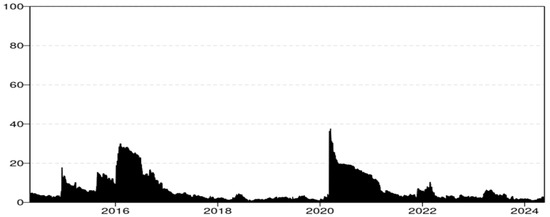
Figure 2.
Dynamic spillover “Total Connectedness Index (TCI)” of assets.
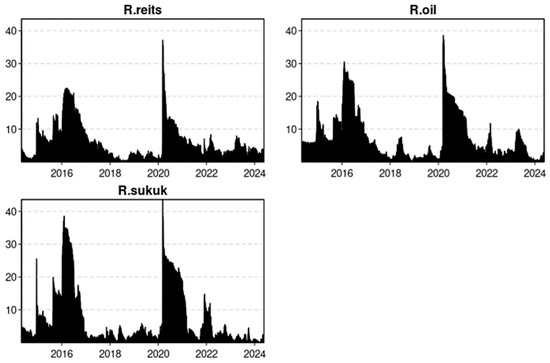
Figure 3.
Dynamic spillover—“From Others”.
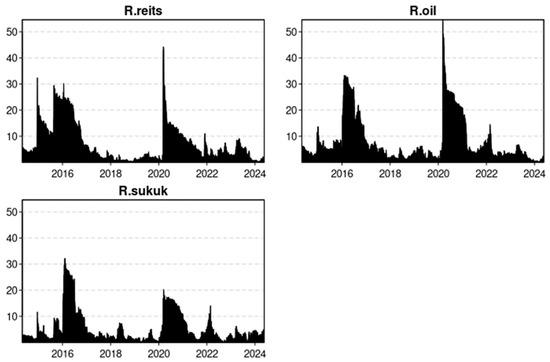
Figure 4.
Dynamic spillover—“To Others”.
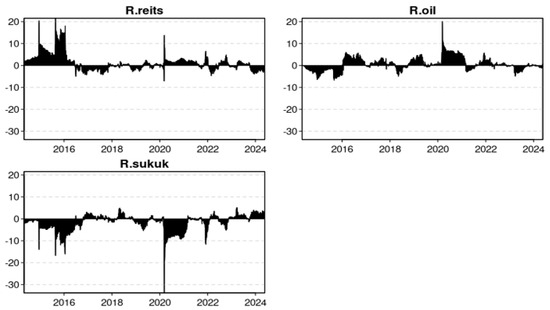
Figure 5.
Dynamic spillover—“Net Transmitter or Receiver”.
Figure 3 (“From Others”) displays the impact of all series on a specified series. The graph reveals that sukuk experiences the highest volatility spillover from other series. Figure 4 (“To Others”) demonstrates the impact of a particular asset on others. We can see that from 2014 to 2016, REITs transmitted the volatility to others dominantly, and from 2020 up to mid-2021, oil was the main volatility transmitter.
Figure 5 (“Net”) exhibits the difference in total directional connectedness between “from” and “to” networks. “Net” > 0 (<0) means that a particular asset is a net transmitter (receiver) of volatility to (from) the network. Most of the time, REITs and oil markets are net transmitters, with the highest impact from 2014 to 2016 for REITs and in 2021 for oil. The finding is in line with Nazlioglu et al. (2020), who stated that the volatility spillover from oil is more noticeable in Kuwait and Saudi Arabia, where the bond market is in an underdeveloped stage.
The last figure (Figure 6) is net pairwise directional connectedness (NPDC). This figure illustrates the dynamic relationship between two assets. The bilateral level of connectedness is the primary focus of interest. For instance, if NPDC REITs-sukuk > 0 (<0), it indicates that REITs have a greater (lesser) impact on sukuk; in other words, REITs transmit (receive) the volatility to (from) the sukuk market. Therefore, from Figure 6, we can conclude that REITs are net transmitters to sukuk markets. This result is the opposite of Lin’s (2013) study.
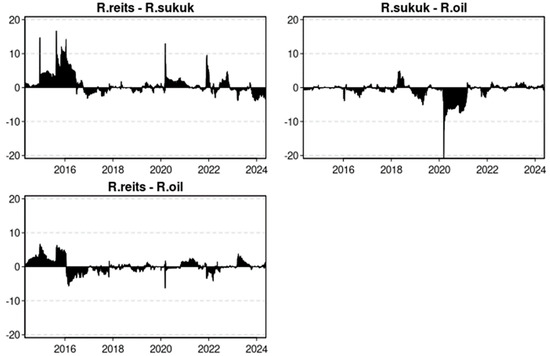
Figure 6.
Dynamic spillover—“Net Pairwise Directional Connectedness (NPDC)”.
Here is a possible explanation: the GCC region links the real estate market to REITs and sukuk. REITs directly invest in real estate properties, while many sukuk issuers finance real estate projects. Variables such as changes in property prices, rental incomes, and occupancy rates drive the volatility in the real estate market. When the real estate market is in turmoil, it affects REITs’ financial performance, which in turn can influence the perception of risk and return in the sukuk market.
Furthermore, Nazlioglu et al.’s (2020) findings confirm that the oil market typically generates the highest volatility for sukuk in GCC countries, as the graph demonstrates. Lastly, the volatility spillover between REITs and oil is reciprocal, meaning that during specific periods, REITs act as transmitters to the oil markets, while during other periods, the opposite is true. This finding is supported by Huang and Lee (2009). However, it is inconsistent with the studies by Fasanya and Oyewole (2023) and Mensi et al. (2023), who argued that REITs transmit volatility to the oil market.
The following is one probable explanation: the economies of the GCC countries, namely Saudi Arabia, Kuwait, the United Arab Emirates, Qatar, Bahrain, and Oman, primarily depend on oil income to fund their national budgets. Oil price fluctuations directly impact government income, subsequently influencing public expenditure, investments, and economic growth. During periods of high oil prices, the real estate market can be positively impacted by increased government expenditure and investment, which in turn can benefit Real Estate Investment Trusts (REITs). In contrast, decreasing oil prices may result in less government expenditure, which can cause a decline in the real estate market, negatively affecting Real Estate Investment Trusts (REITs).
4.3. Hedge Ratio
This section will elaborate on the hedge ratio (HR). The hedge ratio is essential because the HR shows the proportion of one asset’s long (short) position against the second asset’s short (long) position to minimize risk. Table 4 reports the hedge ratio value between assets. For instance, the hedge ratio between sukuk and REITs is 0.33, meaning that a long position of $1 in sukuk is hedged with a REIT short position of $0.33. Furthermore, the hedging ratio sign indicates the investor portfolio’s position. A negative hedging ratio means that the investor should take the opposite position. For example, the hedge ratio between REITs and sukuk is −9.99; it suggests that the investor would short $1 in REITs to hedge against a long position of $9.99 in sukuk.

Table 4.
Hedging ratio.
5. Conclusions
To comprehend the economic stability and investment dynamics of the Gulf Cooperation Council (GCC) countries, it is necessary to closely analyze the interconnections between the financial market and the fluctuations in oil prices. This study investigates the volatility transmission between Real Estate Investment Trusts (REITs), Islamic bonds (sukuk), and oil assets. The results indicate that Real Estate Investment Trusts (REITs) and oil are sources of volatility transmission, whereas sukuk is a recipient of volatility within the network. Examining the net pairwise directional connectedness of two assets, namely REITs and oil markets, reveals that they transfer their volatility to the sukuk market. Moreover, a reciprocal relationship exists between REITs and oil regarding volatility spillover. It means that REITs act as transmitters to the oil markets during specific periods, while the influence is reversed at other times.
An analysis of the interdependence of volatility among REITs, sukuk, and oil in GCC countries yields valuable insights that can aid policymakers in achieving economic stability. It includes formulating strong regulatory frameworks in financial markets, encompassing regulations about transparency, investor protection, and market conduct. Regarding risk management, investors may optimize their portfolio by achieving a balanced exposure distribution across various interconnected markets. Consequently, they can enhance diversification and mitigate the total risk of their portfolio. Furthermore, investors with long-term investment strategies might utilize information derived from volatility connectedness to strategize for the next economic cycles, enabling them to make more robust investment choices that take into account the possible transmission of volatility.
This study’s limitation is that it may not fully account for the unique political and economic factors (such as fluctuations in oil prices and geopolitical tensions) that the GCC countries face, potentially leading to oversights. Moreover, REITs and sukuk markets in the GCC might not be as mature as in other regions, leading to potential biases in the analysis. Future research could expand the scope to include other asset classes such as equities, commodities, or alternative investments to provide a more comprehensive view of financial interdependencies. In addition, comparing the GCC region with other emerging and developed markets could provide insights into how regional characteristics influence volatility connectedness.
Funding
The APC was funded by Prince Sultan University.
Informed Consent Statement
Not applicable.
Data Availability Statement
The data is publicly available.
Acknowledgments
The authors want to acknowledge Prince Sultan University’s support for this publication.
Conflicts of Interest
The author declares no conflict of interest.
References
- Alhassan, Abdulrahman, Mark Anthony Johnson, and Atsuyuki Naka. 2021. Examining Cross-border Comovements of REITs Around the World. Journal of Real Estate Research 43: 290–316. [Google Scholar] [CrossRef]
- Aloui, Chaker, and Hela Ben Hamida. 2021. Oil-stock Nexus in an Oil-rich Country: Does Geopolitical Risk Matter in Terms of Investment Horizons? Defence and Peace Economics 32: 468–88. [Google Scholar] [CrossRef]
- Antonakakis, Nikolaos, Ioannis Chatziantoniou, and David Gabauer. 2020. Refined Measures of Dynamic Connectedness based on Time-Varying Parameter Vector Autoregressions. Journal of Risk and Financial Management 13: 84. [Google Scholar] [CrossRef]
- Antonakakis, Nikolaos, Juncal Cunado, George Filis, David Gabauer, and de Fernando Perez Gracia. 2023. Dynamic connectedness among the implied volatilities of oil prices and financial assets: New evidence of the COVID-19 pandemic. International Review of Economics and Finance 83: 114–23. [Google Scholar] [CrossRef]
- Antonakakis, Nikolaos, Rangan Gupta, and John W. Muteba Mwamba. 2016. Dynamic Comovements Between Housing and Oil Markets in the US over 1859 to 2013: A Note. Atlantic Economic Journal 44: 377–86. [Google Scholar] [CrossRef]
- Balcilar, Mehmet, Rangan Gupta, Shixuan Wang, and Mark. E. Wohar. 2020. Oil price uncertainty and movements in the US government bond risk premia. North American Journal of Economics and Finance 52: 101147. [Google Scholar] [CrossRef]
- Danila, Nevi. 2023a. Bonds and sukuk markets under COVID 19: An empirical study of emerging markets. Buletin Ekonomi Moneter Dan Perbankan 26: 125–44. [Google Scholar] [CrossRef]
- Danila, Nevi. 2023b. Spillover of volatility among financial instruments: ASEAN-5 and GCC market study. PLoS ONE 18: e0292958. [Google Scholar] [CrossRef]
- Demirer, Riza, Roman Ferrer, and Syed Jawad Hussain Shahzad. 2020. Oil price shocks, global financial markets and their connectedness. Energy Economics 88: 104771. [Google Scholar] [CrossRef]
- Diebold, Francis X., and Kamil Yilmaz. 2012. Better to give than to receive: Predictive directional measurement of volatility spillovers. International Journal of Forecasting 28: 57–66. [Google Scholar] [CrossRef]
- Fasanya, Ismail O., and Oluwatomisin J. Oyewole. 2023. On the connection between international REITs and oil markets: The role of economic policy uncertainty. Resources Policy 81: 103335. [Google Scholar] [CrossRef]
- Hanif, Waqas, Tamara Teplova, Victoria Rodina, Mohammed Alomari, and Walid Mensi. 2023. Volatility spillovers and frequency dependence between oil price shocks and green stock markets. Resources Policy 85: 103860. [Google Scholar] [CrossRef]
- Huang, Chien Ming, and Yen Hsien Lee. 2009. The Relationship between oil price growth and REIT Returns. International Research Journal of Finance and Economics 33: 120–33. [Google Scholar]
- Kilian, Lutz. 2008. Exogenous oil supply shocks: How big are they and how much do they matter for the U.S. economy? Review of Economics and Statistics 90: 216–40. [Google Scholar] [CrossRef]
- Killins, Robert N., Peter V. Egly, and Diego Escobari. 2017. The impact of oil shocks on the housing market: Evidence from Canada and U.S. Journal of Economics and Business 93: 15–28. [Google Scholar] [CrossRef]
- Kroner, Kenneth F., and Jahangir Sultan. 1993. Time-Varying Distributions and Dynamic Hedging with Foreign Currency Futures. The Journal of Financial and Quantitative Analysis 28: 535. [Google Scholar] [CrossRef]
- Lin, Pin-Te. 2013. Examining volatility spillover in Asian REIT markets. Applied Financial Economics 23: 1701–5. [Google Scholar] [CrossRef]
- Mensi, Walid, Zhuhua Jiang, Xuan Vinh Vo, and Seong Min Yoon. 2023. Asymmetric volatility transmission and hedging strategies among REIT, stock, and oil markets. Australian Economic Papers 62: 597–615. [Google Scholar] [CrossRef]
- Mezghani, Taicir, and Mouna Boujelbène Abbes. 2023. Influence of oil price fluctuations on the network connectedness between oil, GCC Islamic and conventional financial markets. International Journal of Islamic and Middle Eastern Finance and Management 16: 955–74. [Google Scholar] [CrossRef]
- Nazlioglu, Saban, N. Alper Gormus, and Uğur Soytas. 2016. Oil prices and real estate investment trusts (REITs): Gradual-shift causality and volatility transmission analysis. Energy Economics 60: 168–75. [Google Scholar] [CrossRef]
- Nazlioglu, Saban, Rangan Gupta, Alper Gormus, and Uğur Soytas. 2020. Price and volatility linkages between international REITs and oil markets. Energy Economics 88: 104779. [Google Scholar] [CrossRef]
- Rehman, Mobeen Ur, Neeraj Nautiyal, Rami Zeitun, Xuan Vinh Vo, and Wafa Ghardallou. 2024. Unraveling the multiscale comovement of green bonds and structural shocks: An oil-driven analysis. North American Journal of Economics and Finance 72: 102122. [Google Scholar] [CrossRef]
- Shahzad, Syed Jawad Hussain, Chaker Aloui, Rania Jammazi, and Muhammad Shahbaz. 2019. Are Islamic bonds a good safe haven for stocks? Implications for portfolio management in a time-varying regime-switching copula framework. Applied Economics 51: 219–38. [Google Scholar] [CrossRef]
- Sharif, Arshian, Chaker Aloui, and Larisa Yarovaya. 2020. COVID-19 pandemic, oil prices, stock market, geopolitical risk and policy uncertainty nexus in the US economy: Fresh evidence from the wavelet-based approach. International Review of Financial Analysis 70: 101496. [Google Scholar] [CrossRef]
- Tien, Ho Thuy, and Ngo Thai Hung. 2022. Volatility spillover effects between oil and GCC stock markets: A wavelet-based asymmetric dynamic conditional correlation approach. International Journal of Islamic and Middle Eastern Finance and Management 15: 1127–49. [Google Scholar] [CrossRef]
- Umar, Zaghum, Afsheen Abrar, Sinda Hadhri, and Tatiana Sokolova. 2023. The connectedness of oil shocks, green bonds, sukuks and conventional bonds. Energy Economics 119: 106562. [Google Scholar] [CrossRef]
- Umar, Zaghum, Sinda Hadhri, Emmanuel Joel Aikins Abakah, Muhammad Usman, and Muhammad Umar. 2024. Return and volatility spillovers among oil price shocks and international green bond markets. Research in International Business and Finance 69: 102254. [Google Scholar] [CrossRef]
- Zhao, Yu, Linbo Chen, and Yu Zhang. 2024. Spillover effects of geopolitical risks on global energy markets: Evidence from CoVaR and CAViaR-EGARCH model. Energy Exploration and Exploitation 42: 772–88. [Google Scholar] [CrossRef]
Disclaimer/Publisher’s Note: The statements, opinions and data contained in all publications are solely those of the individual author(s) and contributor(s) and not of MDPI and/or the editor(s). MDPI and/or the editor(s) disclaim responsibility for any injury to people or property resulting from any ideas, methods, instructions or products referred to in the content. |
© 2024 by the author. Licensee MDPI, Basel, Switzerland. This article is an open access article distributed under the terms and conditions of the Creative Commons Attribution (CC BY) license (https://creativecommons.org/licenses/by/4.0/).